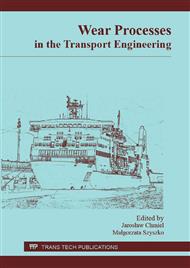[1]
Oilseeds: World Markets and Trade, United States Department of Agriculture, Foreign Agricultural Service, June (2015).
Google Scholar
[2]
H. Fauduet, J.P. Coic, M. Lessire, A. Quinsac, D. Ribaillier, P. Rollin, Rapeseed meal upgrading –pilot scale preparation of rapeseed meal materials with high or low glucosinolate contents, Animal Feed Science and Technology 56 (1995), 99-109.
DOI: 10.1016/0377-8401(95)00811-z
Google Scholar
[3]
M. Bojanowska, R. Leśmian-Kordas, Wybuchowość pyłów śruty rzepakowej, Towaroznawcze problemy jakości [Explosiveness of rapeseed meal dust, Polish Journal of Commodity Science], 1 (2009), 102-115 [in Polish].
Google Scholar
[4]
D. Rotkiewicz, R. Zadernowski, Obłuskiwanie nasion rzepaku, Rośliny Oleiste, [Rape seed dehulling, Oilseed crops] tom XVIII (1997), 493-504 [in Polish].
DOI: 10.5604/12338273.1083533
Google Scholar
[5]
K. Mińkowski, Influence of dehulling of rape seeds on chemical composition of meal, Animal Feed Science and Technology, 96 (2002), 237-244.
DOI: 10.1016/s0377-8401(01)00284-x
Google Scholar
[6]
F. Sosulski, R. Zadernowski, Fractionation of rapeseed meal into flour and hull components, J. Am. Oil Chem. Soc. 58 (1981), 96-98.
DOI: 10.1007/bf02672189
Google Scholar
[7]
M. Chibowska, S. Smulikowska, B. Pastuszewska, Metabolisable energy value of rapeseed meal and its fractions for chickens as affected by oil and fibre content, Journal of Animal and Feed Science, 9 (2000), 371-378.
DOI: 10.22358/jafs/68054/2000
Google Scholar
[8]
I. Jackowska, J. Tys., Factors modifying fatty acid composition in rapeseed (cultivar, harvest tine), Electronic Journal of Polish Agricultural Universities, 9 (2006).
Google Scholar
[9]
L.O. Sakhno, Variability in the Fatty Acid Composition of Rapeseed Oil: Classical Breeding and Biotechnology, Cytology and Genetics, 44 (2010), 389-397.
DOI: 10.3103/s0095452710060101
Google Scholar
[10]
M. Tańska, D. Rotkiewicz, M. Ambrosewicz, Technological value of selected polish varieties of rapeseed, Polish Journal of Natural Sciences, vol. 24 (2009), 122-132.
DOI: 10.2478/v10020-009-0012-z
Google Scholar
[11]
S.K. Jensen, Y.G. Liu, B.O. Eggum, The influence of seed size and hull content on the composition ad digestibility of rapeseeds in rats, Animal Feed Science and Technology 54 (1995), 9-19.
DOI: 10.1016/0377-8401(94)00762-x
Google Scholar
[12]
B. Pastuszewska, G. Jabłecki, E. Święch, L. Buraczewska, A. Ochtabińska, Nutritional value of rapeseed meal containing lecithin gums precipitated with citrid acid, Animal Feed and Science Technology, 86 (2000), 117-123.
DOI: 10.1016/s0377-8401(00)00162-0
Google Scholar
[13]
http: /www. adm. com/en-US/products/Documents/ADM-Feed-Ingredients-Catalog. pdf.
Google Scholar
[14]
M. Naczk, T. Nichols, D. Pink, F. Sosulski, Condensed Tannins in Canola Hulls, Journal of Agricultural and Food Chemistry, 42 (1994), 2196-2200.
DOI: 10.1021/jf00046a022
Google Scholar
[15]
R.K. Eckhoff, Dust Explosions in the Process Industries. Butterworth-Heinemann, Oxford (2002).
Google Scholar
[16]
T. Abbasi, S.A. Abbasi., Dust explosion – Cases, causes, consequences and control, Journal of Hazardous Materials, 140 (2007), 7-44.
DOI: 10.1016/j.jhazmat.2006.11.007
Google Scholar
[17]
Á. Ramírez , J. García-Torrent., P.J. Aguado., Determination of parameters used to prevent ignition of stored materials and to protect against explosions in food industries, Journal of Hazardous Materials, 168 (2009), 115-120.
DOI: 10.1016/j.jhazmat.2009.02.013
Google Scholar
[18]
D.S. Jayas, N.D.G., White, Engineering properties and spoilage susceptibility od canola meal, GCIRC 1991 Congress.
Google Scholar
[19]
W. Bartknecht, Dust Explosion – Course, Prevention, Protection, Springer-Verlag, Berlin Heidelberg (1989).
Google Scholar
[20]
A. Sturaro, R., Rella, G. Parvoli, D. Ferrara, L. Doretti, Chemical evidence and risks associated with soybean and rapeseed meal fermentation, Chemosphere 52 (2003), 1259-1262.
DOI: 10.1016/s0045-6535(03)00448-x
Google Scholar
[21]
http: /www. producer. com/2008/04/explosion-rocks-man-canola-plant.
Google Scholar
[22]
http: /www. cbc. ca/news/canada/saskatchewan/explosion-fire-at-yorkton-sask-canola-plant-1. 2811805.
Google Scholar
[23]
J. Chmiel, B. Drzewieniecka et al. Problemy zużycia taśm przenośnikowych w transporcie nasion roślin oleistych (The problems of wear of conveyor belts for transport oilseeds), Problemy eksploatacji, nr 4/2010 (79) s. 207-214, ISSN 1232-9312.
Google Scholar
[24]
B. Wiśniewski, T. Wolski, Hydrometeorologiczne Uwarunkowania pracy Portu w Szczecinie Marine Science 5. Nr 243, 1988 pp.7-23.
Google Scholar


